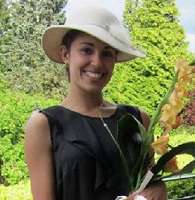Choreography has long been a male dominated sphere, something that 'She Said', a programme of new work by female choreographers who are each building an international reputation, is trying to remedy. Tamara Rojo, English National Ballet director has taken a giant leap towards equality by commissioning this very successful evening where even the front cloth, painted by artist Grayson Perry, is girl-power themed, giving me the warm and fuzzy feeling of getting four-for-the-price-of-three as I studied its images while the auditorium was filling up.
The evening opened with Broken Wings by Annabelle Lopez Ochoa, working in partnership with dramaturg Nancy Meckler. It presents the colourful and chaotic imagination of Mexican artist Frida Khalo and tells the story of her singular life. Tamaro Rojo stars as Frida, summoning all her star power and wonderful intuition as a dance actress to bring the artist’s work to life in movement. It is an impressionistic narrative, appropriately for an artist whose work presents the surrealism of the subconscious so beautifully.
Irek Mukhamedov is magnetic, managing to completely embody the philandering Diego Rivera while never tearing our attention away from either the woman or her art.
Of course, what is intriguing about the concept of dancing about art is the layers through which we see the images. Here is Khalo’s imagination filtered through the lens of Lopez Ochoa’s, which is blended with that of designer Dieuweke van Reij and then, of course portrayed by the dancers. And so we are beguiled by mysterious images; a wounded faun, painted and petticoated men and skeletons in sombreros; art forms calling to each other across the years and the oceans to create new tributes to age-old ideas.
Full disclosure: I love anything to do with Ancient Greece. So the second piece on the programme, M-Dao by Chinese choreographer Yabin Wang was a personal favourite. I feel she has captured something of a zeitgeist in this atmospheric ballet about the Greek myth of Medea, as there have been some wonderful presentations of Greek tragedy in London recently and I feel this work will be a great addition to them. The haunting use of a female vocalist in the music composed by Jocelyn Pook and stunning projections, as well as some beautiful use of long white drapes and the shadows cast behind them gave this work a timeless appeal. Laurretta Summerscales was a wild and weird Medea who completely held my attention and I’m sure I’m not alone in look forward to seeing what she will do with the repertoire that will present itself next. The unusual choice to have Medea clad in only one pointe shoe was an interesting one, something that an audience of two thousand years ago might have appreciated more than the theatre goer of today. For only wearing one shoe- (‘Monosandalism’ is, would you believe it, the correct term among classicists) symbolises a journey to the edges of society and known boundaries, something that Medea surely does as she murders her children to take revenge on the lover who jilted her. But here’s the best bit; only wearing one sandal is mostly associated in Greek art with Jason, Medea’s cheating boyfriend! This bold and unusual choice and the beautiful execution of the ideas added up to a blisteringly powerful performance that I enjoyed very much.
The evening concluded with Aszure Barton’s Fantastic Beings, a plotless piece that seemed like sand dunes in the desert; shifting constantly, never fully pinned down. The music, Anthology of Fantastic Zoology, by Mason Bates is based on a collection of short stories of the same name by Jorge Luis Borges, and interestingly the piece left me with a similar feeling to one I am left with when reading anything by this author. I know it is interesting and I know it is clever, but it seems to be operating on a level that hovers just out of reach of my understanding, no matter how hard I try.
A huge blinking eye seems to suggest a theme at some point, as did the fringed monster outfits, but the piece stubbornly eluded a definitive interpretation. The dancers sculpt space collectively, their identical costumes stripping the performer’s individuality right back, back to each dancer’s unique way of moving and I found it pleasant enough just to watch the stage fill and empty again, once I had accepted that I would not exactly ‘get’ it.
This programme amply fulfilled what must have been Tamara Rojo’s aim in commissioning it: demonstrating that there are female choreographers with buckets to say and powerful creative instincts to shout it on the stage. Here’s to hoping this programme inspires the next generation of artists to create work as fearless as this in years to come.


